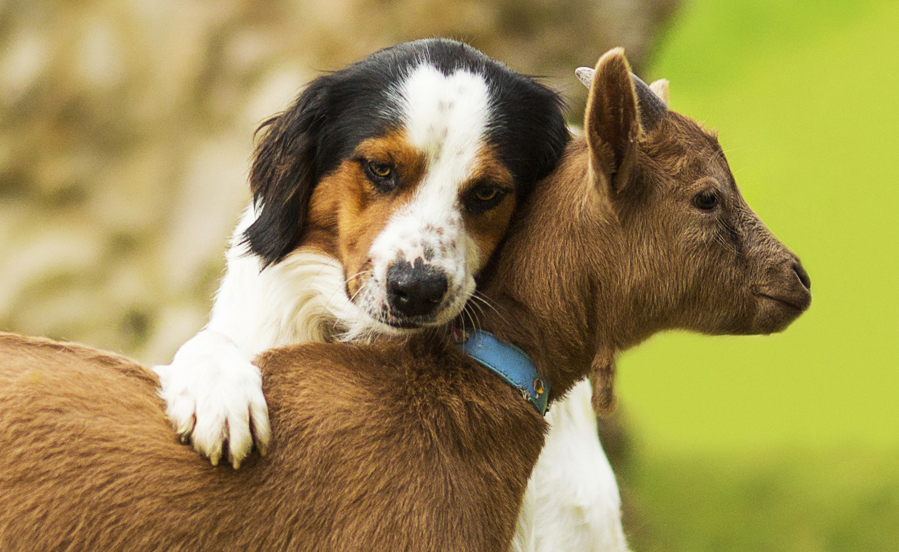Goats, creepy-eyed darlings of the Internet age, have become a trendy pet in recent years. But human influence on the noble goat goes back much further than the latest hipster craze. In fact, goats are thought to be the second-oldest domesticated animal. While our love affair with canines stretches so far back that scientists can’t be sure when it began, goats clock in second at 11,000 years of domestication.
According to new research published in Biology Letters, those 11,000 years of farming have left goats with a surprising trait: They look to humans for help.
“Goats gaze at humans in the same way as dogs do when asking for a treat that is out of reach,” author Christian Nawroth said.
Until now, only horses and dogs have been shown to use directed gazes to communicate with humans. In experiment set-ups known as “unsolvable problem” tasks, animals are trained to retrieve treats from a box, then given a box they don’t know how to open while nearby humans either face them or turn away. In studies of domesticated dogs and horses, the animals have been shown to turn their gazes on the front-facing humans, as if using eye contact to implore them to assist.
Gaze behavior
It’s one thing to tame an animal; it’s another to domesticate one. You can see a great example of this in the pet fox industry: So-called tame foxes can be bought for a few hundred dollars. They’ve been raised by humans, so they might adapt to living in your home reasonably well — but they’re still wild. Domesticated foxes come from a facility in Siberia that’s been breeding them for over half a century, mating only those foxes that do well living as human pets. The resulting critters are doglike and trainable.
Domestication has fascinating side-effects that we don’t yet fully understand. In one study on dogs using the gaze behavior described above, researchers found that “tame” wolves — ones raised by humans — didn’t turn their eyes on human bystanders when they needed help. That suggests that this level of interspecies interaction is something developed over many generations.
Goats have certainly had time to develop such a behavior, but researchers were surprised to see them staring at human handlers in times of trouble.
“The key difference is that these goats have not been bred as companion animals or pets,” Queen Mary University of London’s Alan McElligott, author of the study, said. “The other animals studied, those were domesticated to work fairly closely with humans, as guard dogs or companion dogs or in the case of horses, to be ridden. So we thought goats would be a very useful model to compare them to, because they were domesticated for milk, meat, and hair instead.”
In other words, the gaze behavior held — even though goats weren’t bred to be our buddies, but our breakfast. The experimental goats looked back and forth between the inaccessible treats and the human observers like puppies. They also seemed more likely to look at the humans when they were facing forward, and looked at them earlier, more often, and for longer periods.
“These results are pretty surprising,” Laurie Santos, who studies animal cognition at Yale’s Canine and Primate Laboratory, told The Post in an email.
The results suggest that domestication, even for such nonsocial reasons as meat and milk, can create animals that understand human gaze cues.
“This is exciting, as it shows how little we still understand about how the process of domestication can shape rich social understanding,” Santos said.
McElligott said he thinks it would be fascinating to try to replicate the results in animals domesticated for similar purposes, such as cows or sheep. The goats used in the study are used to humans, having been cared for at the Buttercup Sanctuary for Goats. That’s a necessary component of the experiment, he explained. If scientists took a gang of pastured goats who rarely interacted with humans in a positive way and ran the same tests, they couldn’t be sure that animals who bucked the gaze trend weren’t afraid of people.
Welfare guidelines
Broader implications aside, the research team is excited to continue figuring out how goats got to be the way they are. When McElligott — who was raised on a farm in Ireland and kept a couple of pet goats — first entered the field, only one lab in the world was studying goat cognition.
“Our primary long-term goal is helping to improve welfare guidelines,” he said. “Currently there are about a billion goats on the planet being used for agriculture, but still most of the welfare guidelines for keeping them come from sheep. Anyone who’s worked with goats and sheep know they’re quite different.”
The bottom line, he said, is that the animals are a lot smarter than we give them credit for — and they’re very well domesticated.
“It’s not as if goats will suddenly take over as the new urban pet, replacing cats and dogs,” McElligott said.



